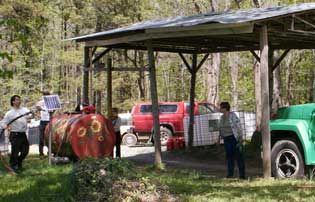Biodiesel – the real deal
 Sunday was a gorgeous spring day, but Laura had to work, and so I took the gang out on little road trip to the Biofuels Coop in Chatham County. When we got there, Lyle was just showing a group of people around the farm and the biodiesel production. While the kids were chasing a goat around and petting the dogs, the group had some pretty good discussions, from glycerol disposal to the cost of biodiesel and the plans for the coop’s commercial biodiesel plant in Pittsboro.
Sunday was a gorgeous spring day, but Laura had to work, and so I took the gang out on little road trip to the Biofuels Coop in Chatham County. When we got there, Lyle was just showing a group of people around the farm and the biodiesel production. While the kids were chasing a goat around and petting the dogs, the group had some pretty good discussions, from glycerol disposal to the cost of biodiesel and the plans for the coop’s commercial biodiesel plant in Pittsboro.
After the tour, figuring I should put my $$$ where my mouth is, I signed up for a membership and filled up the Jetta with “the good stuff” – 100 percent biodiesel. I also got some biodiesel “to go” in 2 five-gallon carboys, so I should be good for a month. For my next trip over there I have to figure out a good way to haul a bunch more of this stuff, to make it worth the 100-mile round-trip.
The difference in the “quality” of the exhaust fumes is truly amazing, even compared to the B20 I’ve been burning. None of that characteristic diesel smell or smoke. Ahh – the smell of my good karma growing :)!
According to DOE/USDA and EPA life-cycle studies, compared to fossil diesel, B100 reduces:
- net carbon dioxide emissions by 78 percent (source)
- total unburned hydrocarbons by 67 percent (source)
- carbon monoxide by 48 percent (source)
- particulate matter by 47 percent (source)
Naturally, these numbers vary, depending on the type of oil and the quality of the biodiesel, as well as the type of engine. In fact, it sounds like a lot of the government studies are based on bus and truck engines. But still, we’re not talking about reducing pollution by 5 or 10 percent – we’re talking about reducing major pollutants by 40-80 percent. And, of course, the stuff also does grow back, unlike the dino fuels.